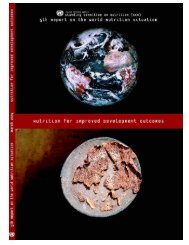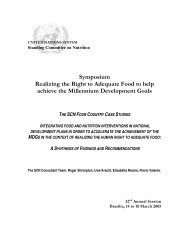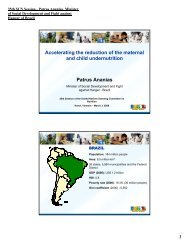Universal Salt Iodization (USI) - FTP Directory Listing
Universal Salt Iodization (USI) - FTP Directory Listing
Universal Salt Iodization (USI) - FTP Directory Listing
- No tags were found...
You also want an ePaper? Increase the reach of your titles
YUMPU automatically turns print PDFs into web optimized ePapers that Google loves.
www.unsystem.org/scn FEATURES 17television station to a thousand county stations. Initial feedback indicated that these programmes enabledwide dissemination of messages to the most critical target audiences (UNICEF 2002b).The way forwardSince the 2002 UN Special Session on Children, many countries have reported continued progress towardsachievement of the <strong>USI</strong>/IDD goal (UNICEF 2007). However, there are also countries which have not madetangible progress and need additional support to accelerate their efforts towards the elimination of iodinedeficiency. In 2006, UNICEF identified sixteen “make or break” countries which needed to make specialefforts and required extended support beyond 2005. The selection criteria singled out countries with a highnumber of unprotected newborns, a high level of salt production, a low level of salt iodization, as well as aneed for special advocacy and professional support to renew strategies of the national IDD elimination programmes.The list includes those major countries which significantly contribute to regional and global coveragesuch as India, China and the Russian Federation (Figure 2). The analyses of the global database suggestthat if the 16 make or break countries achieve <strong>USI</strong>, then the global average of households consuming iodizedsalt would be about 85%. Based on over two decades of lessons in <strong>USI</strong> programmes, we have learnedthat there are five guiding principles which are crucial to success of the elimination of IDD through <strong>USI</strong>:▪ Securing political commitment and advocacy. Strong, continued government commitment and industrymotivation are essential. Political commitment needs to be renewed through periodic advocacy events.▪ Effective education and communications. Sustained communications through mass media, school, andhealth systems are essential in educating the public and salt producers about the elimination of IDD.▪ Ensuring iodized salt supply. While voluntary iodization is beneficial in individual situations, mandatoryiodization will ensure universal practice and access. Monitoring and enforcement of agreed-upon actionsare important.▪ Forming national oversight coalitions. National and sub-national coalitions provide practical and effectivemechanisms to raise and sustain commitments to IDD elimination. Forming national coalitions with clearlydefined roles and responsibilities can play a major, driving role in reviewing monitoring information forplanning and promotion of collaborative work. Producers should consider forming salt associations in orderto use their influence to ensure universal supply and access.▪ Effective monitoring systems. A regular and effective monitoring system to check salt iodine levels fromproduction to household is instrumental to a successful program. Another key component of salt monitoringis to assure quality at the point of production. Reporting and sharing results of regional and national iodinenutrition program monitoring are important to ensure the effectiveness of the programmes.ReferencesBehrman JR AH, Hoddinott J (2004) Hunger and Malnutrition. Copenhagen Consensus – Challenges and Opportunities.Copenhagen.Bleichrodt N, Born M (1994) A meta-analysis of research into iodine and its relationship to cognitive development. In:Stanbury JB (ed) The damaged brain of iodine deficiency. Communication Corporation:New York, 195-200.Burgi H, Zimmermann MB (2005) <strong>Salt</strong> as a carrier of iodine in iodine deficient areas. Schweiz Monatsschr Zahnmed115: 648-50.Delange F (1994) The disorders induced by iodine deficiency. Thyroid 4: 107-28.Delange F (1999) What do we call a goitre? Eur J Endocrinol 140: 486-8.Delange F, de Benoist B, Pretell E, Dunn J (2001) Iodine deficiency in the world: where do we stand at the turn of thecentury? Thyroid 11, 437-47.Hetzel BS (1983) Iodine deficiency disorders (IDD) and their eradication. Lancet 2: 1126-9.Jooste PL (2003) Assessment of the iodine concentration in table salt at the production stage in South Africa. Bull WorldHealth Organ 81: 517-21.Kiwanis International (2007) Worldwide Service: Kiwanis International & U.S. Fund for UNICEF giving children ASMART START in life. (online)back to contents SCN NEWS # 35







